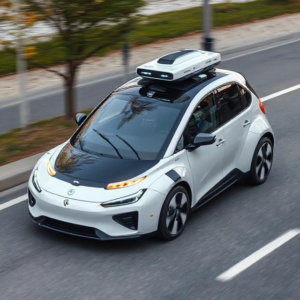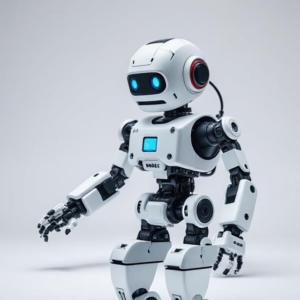1. What is an Autonomous Vehicle?
- An autonomous vehicle (also called a self-driving car) is a car that can drive itself without needing a human to control the steering, brakes, or acceleration.
- These vehicles use a combination of sensors, software, and electronics to perceive their surroundings and make decisions, just like a human driver would.

2. Key Components of Autonomous Vehicle Electronics
Autonomous vehicles rely heavily on electronics to function. Here are the key components that make it all work:
A. Sensors
Sensors are the eyes and ears of an autonomous vehicle. They help the car “see” and understand what’s happening around it. There are several types of sensors in autonomous vehicles:
- Lidar (Light Detection and Ranging):
- Lidar uses laser beams to create a 3D map of the vehicle’s surroundings. It helps the car understand the shape, distance, and position of objects around it.
- It’s like a super-accurate version of your car’s radar, but it provides more detailed information about objects like pedestrians, other cars, and road signs.
- Radar (Radio Detection and Ranging):
- Radar uses radio waves to detect objects around the vehicle. It works well in bad weather conditions, such as fog or rain, where lidar or cameras might struggle.
- Radar helps the car detect the distance and speed of objects like other vehicles, cyclists, or obstacles.
- Cameras:
- Cameras help the car “see” like humans do. They capture images and video, and the vehicle’s software uses computer vision to identify things like lane markings, traffic lights, pedestrians, and other road users.
- Cameras are important for recognizing signs, reading traffic signals, and understanding the environment.
- Ultrasonic Sensors:
- These are used for close-range detection, like parking sensors. They help the car understand the distance to objects that are very close, like curbs or walls when parking or maneuvering in tight spaces.
- GPS (Global Positioning System):
- GPS helps the vehicle know where it is on the map. It uses satellites to provide location data and helps the car navigate along a pre-planned route.
B. Processing Units
Once the sensors collect data, the car needs to process all that information to make decisions. This is done by powerful computers and processors in the vehicle, such as:
- Central Processing Unit (CPU):
- The CPU is the brain of the vehicle’s electronics. It handles data from sensors and makes decisions based on algorithms and machine learning models.
- It’s responsible for making decisions like when to stop, steer, or accelerate based on input from the sensors.
- Graphics Processing Unit (GPU):
- The GPU helps process visual data from the cameras and lidar. It’s good at handling computer vision tasks, like identifying objects in the environment.
- Machine Learning:
- Machine learning algorithms allow the car to improve its decision-making over time. The car “learns” from its experiences and can adapt to new situations.
C. Control Units and Actuators
The control units and actuators are responsible for actually moving the car based on the decisions made by the processing unit. These include:
- Steering Control:
- The steering control system allows the car to turn left or right. It is connected to the processing unit, which sends signals to turn the steering wheel.
- Brakes and Acceleration:
- The vehicle has a braking system and accelerator that can be controlled electronically. The control unit adjusts the speed by applying brakes or accelerating based on the environment and the car’s path.
- Throttle Control:
- This system controls how fast the car accelerates. It’s also managed by the processing unit based on the speed limits, traffic conditions, and road types.
D. Connectivity and Communication
Autonomous vehicles often need to communicate with each other and with infrastructure around them (like traffic lights or road signs). This is done through Vehicle-to-Everything (V2X) communication:
- V2X Communication: This allows the vehicle to talk to other vehicles, traffic signals, pedestrians, and even road signs to improve safety and efficiency. For example, the car might get a signal that a traffic light is about to turn red, so it can slow down ahead of time.
E. Software and Algorithms
- The heart of autonomous driving is the software. The software processes all the data from sensors and makes decisions about what the car should do next (like when to stop, accelerate, or turn).
- It also uses algorithms for things like path planning (deciding the best route), object detection (recognizing pedestrians or other vehicles), and decision-making (deciding when to pass a car or make a turn).
F. Human-Machine Interface (HMI)
- Although autonomous vehicles can drive themselves, they still need to communicate with humans. The HMI (Human-Machine Interface) is the system that allows the driver (or passengers) to interact with the vehicle. It could be a screen showing the car’s status, upcoming turns, or a voice assistant that gives instructions.
3. How Does the Car Make Decisions?
The car’s computer uses all the data from its sensors to understand the environment around it. Here’s how it works:
- Perception: The car uses sensors like lidar, radar, and cameras to see the world around it.
- Localization: The car uses GPS and mapping data to figure out exactly where it is on the road.
- Planning: The car’s software figures out the best route to take, how to avoid obstacles, and how to drive safely.
- Control: Finally, the car uses its control systems to move (steering, braking, and accelerating).
4. Safety and Redundancy
Since autonomous vehicles are responsible for human safety, they include redundant systems to make sure they can still function even if something fails:
- If one sensor or component stops working, the car can rely on others (like using radar if cameras stop working).
- There are backup systems for critical functions like braking, steering, and power, ensuring the car remains safe.
5. Challenges in Autonomous Vehicle Electronics
Even though the technology is advancing rapidly, there are still challenges:
- Weather and Lighting: Sensors like lidar and cameras can struggle in bad weather (rain, fog, snow) or in very bright or dark environments.
- Complex Environments: Urban areas with lots of pedestrians, cyclists, and unpredictable drivers can be tough for autonomous systems to navigate.
- Ethical Decisions: Autonomous vehicles need to make decisions in dangerous situations (like what to do if a pedestrian suddenly crosses the street), which raises ethical concerns.
Summary
Autonomous vehicle electronics are made up of many key components working together:
- Sensors (like cameras, lidar, and radar) help the car “see” the world around it.
- Processing units (like CPUs and GPUs) process the data and make decisions.
- Control units and actuators execute the car’s movements (steering, braking, acceleration).
- Connectivity allows the car to communicate with other vehicles and infrastructure.
- Software and algorithms help the car understand the environment, plan a route, and make safe driving decisions.
All of this technology allows autonomous vehicles to drive themselves safely, though there are still challenges to overcome before they can become mainstream. But these electronics are the backbone of self-driving cars.











